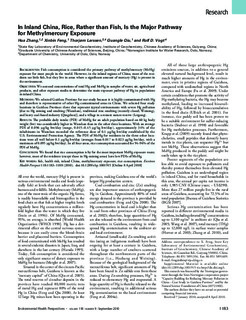In Inland China, Rice, Rather than Fish, Is the Major Pathway for Methylmercury Exposure
Journal article, Peer reviewed
Published version
Permanent lenke
http://hdl.handle.net/11250/2492004Utgivelsesdato
2010Metadata
Vis full innførselSamlinger
- Publikasjoner fra Cristin - NIVA [2147]
- Scientific publications [1172]
Originalversjon
Environmental Health Perspectives. 2010, 118 (9), 1183-1188. Reproduced with permission from Environmental Health Perspectives. 10.1289/ehp.1001915Sammendrag
Background: Fish consumption is considered the primary pathway of methylmercury (MeHg) exposure for most people in the world. However, in the inland regions of China, most of the residents eat little fish, but they live in areas where a significant amount of mercury (Hg) is present in the environment. O b jectives: We assessed concentrations of total Hg and MeHg in samples of water, air, agricultural products, and other exposure media to determine the main exposure pathway of Hg in populations in inland China. Methods: We selected Guizhou Province for our study because it is highly contaminated with Hg and therefore is representative of other Hg-contaminated areas in China. We selected four study locations in Guizhou Province: three that represent typical environments with severe Hg pollution [due to Hg mining and smelting (Wanshan), traditional zinc smelting (recently closed; Weining), and heavy coal-based industry (Qingzhen)], and a village in a remote nature reserve (Leigong). R esults: The probable daily intake (PDI) of MeHg for an adult population based on 60 kg body weight (bw) was considerably higher in Wanshan than in the other three locations. With an average PDI of 0.096 μg/kg bw/day (range, 0.015–0.45 μg/kg bw/day), approximately 34% of the inhabitants in Wanshan exceeded the reference dose of 0.1 μg/kg bw/day established by the U.S. Environmental Protection Agency. The PDI of MeHg for residents in the three other locations were all well below 0.1 μg/kg bw/day (averages from 0.017 to 0.023 μg/kg bw/day, with a maximum of 0.095 μg/kg bw/day). In all four areas, rice consumption accounted for 94–96% of the PDI of MeHg. C onclusion: We found that rice consumption is by far the most important MeHg exposure route; however, most of the residents (except those in Hg-mining areas) have low PDIs of MeHg.
